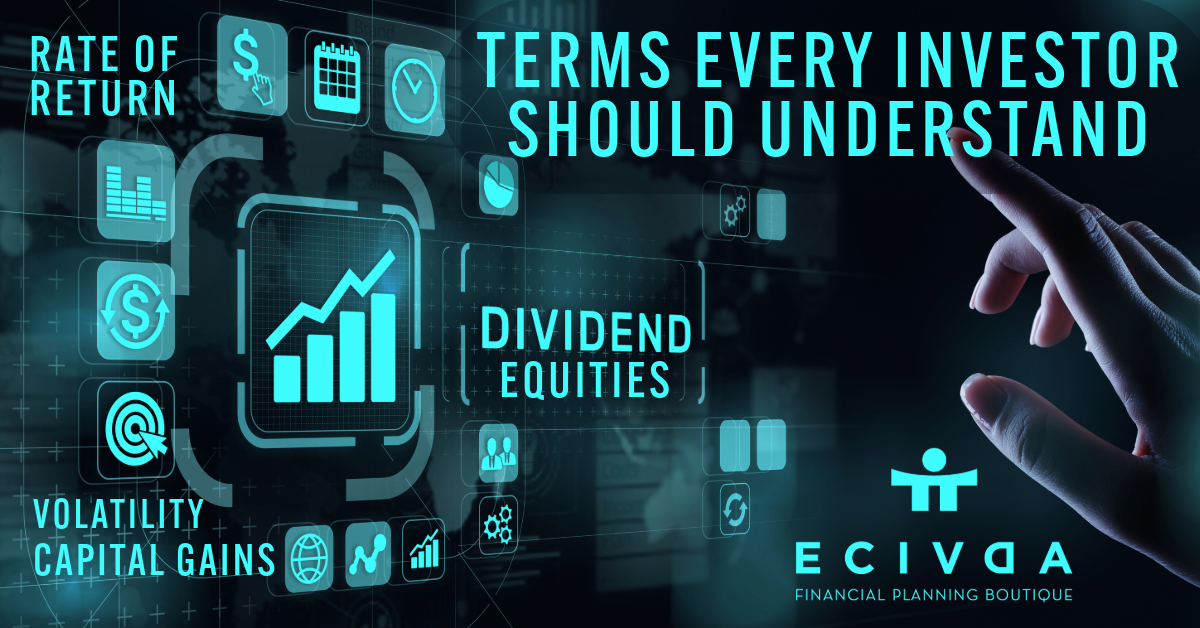Terms Every Investor Should Understand
Executive Summary
Investing today, whether for the short-term, long-term or in-retirement, can be complicated. An Advisor can guide you but there are many terms that investors should know in order to best understand the direction, recommendations and outcomes of their investments.
The following is a glossary of terms to help you understand some of the jargon and technical terms you have heard, and will likely hear again. Please use it as a reference tool.
Investment Terms
- Rate of Return: gain or loss of an investment expressed as a percentage of the invested capital and is calculated on an entire investment portfolio to determine performance. Planning your Rate of Return to match financial goals and your risk/reward profile is a necessary step to successful investment planning.
- Asset Allocation is an investment strategy that balances Risk and Return by placing investments inside an investment portfolio into different Asset Classes like equities/stocks, fixed income, and cash. Each class has its own characteristics and can contribute more to the total as proportions increase. Asset allocation helps manage risks and rewards to meet your financial needs.
- Equities is a broad term used to describe ‘stocks’ or shares of a company. Most owners of shares believe they own shares, but, in fact, they own the company. In the case of publicly traded companies people investing for retirement own a very small percentage of the company, but they are the owners.
- Fixed Income is a category of investments that generate interest at a predictable, stable amount. Fixed income instruments inside a portfolio are often meant to be the safest investments. In the case of GICs, the balance is guaranteed by insurance and the interest payments typically have a very strong track record of occurring.
- Cash and Cash-like instruments are highly liquid investments. These investments can take advantage of market opportunities, and accommodate short-term unexpected personal expenditures without forcing the sale of an investment at an inopportune time.
- Capital Gains: Increase (or loss) in the value of a security at the time it is sold versus its cost when purchased. Since capital gains are taxed in Canada at a lower rate than interest income, depending on the province or territory, the highest marginal tax rate for capital gains is approximately 25%.
- Interest Income: Payments made to the owner of capital for the use of that capital and is calculated by multiplying the capital amount by the interest rate being paid for a particular period of time. Example – a $10,000, one-year annual-pay GIC paying 1.5% generates $150 of interest income each year, and would be paid on the anniversary date.
- Dividends: Payments made monthly, quarterly, semi-annually or annually to the “owner of record” of a share of a company. The dividend yield is calculated by dividing the expected dividend for the next year by the current share price.
- Basis Points a single basis point is one-one hundredth (1/100th) of a percentage point (1%) or 0.0001. Mathematically, a basis point is equal to one ten-thousandth. Basis Points are used to express very small changes in numbers like percentages or the value of the Canadian dollar compared to the US dollar, for example.
- Volatility: the reaction of an investment to changes in the overall market. In other words, if the market goes up by 10%, will the stock react more, less or the same. Volatility is called ‘Beta.’ An investment’s Beta expresses how it reacts relative to the market, meaning the stock market in total.
- Diversification is a way to mitigate risk by placing investments in different kinds of investments (see Asset Allocation above) and by placing investments within an asset class in different industries, sectors, countries, etc. Diversification is a method used to manage risk by not having all of your eggs in one basket. If a country or an industry or a single company has a bad day, month or year your entire portfolio will have a measure of protection by being spread around.
The Bottom Line
We are here to help guide and advise you through the sometimes complicated world of finances and investments. To best understand our recommendations and their implications it is important for you to understand investment terminology. Keep this filed away as a tool for your reference or contact us for assistance or clarification anytime.
